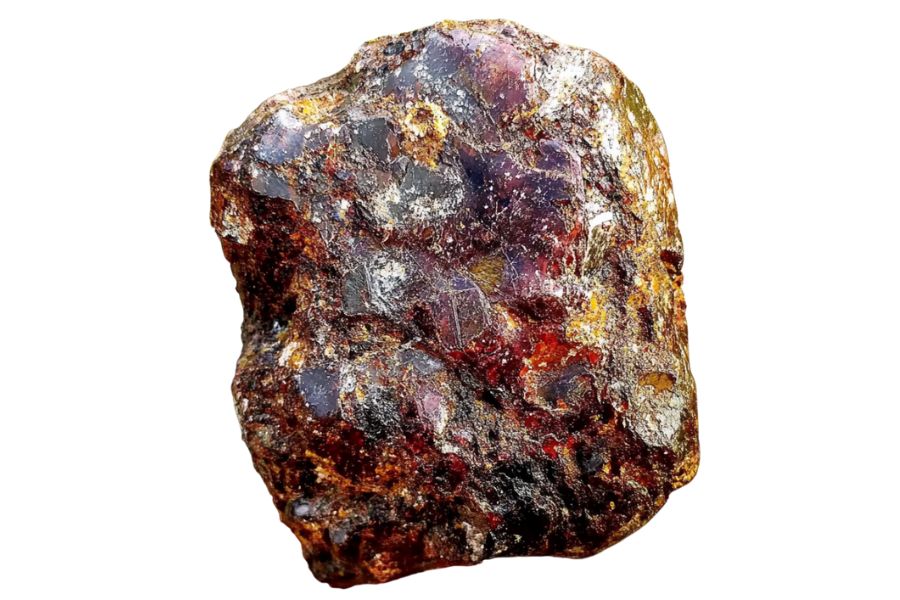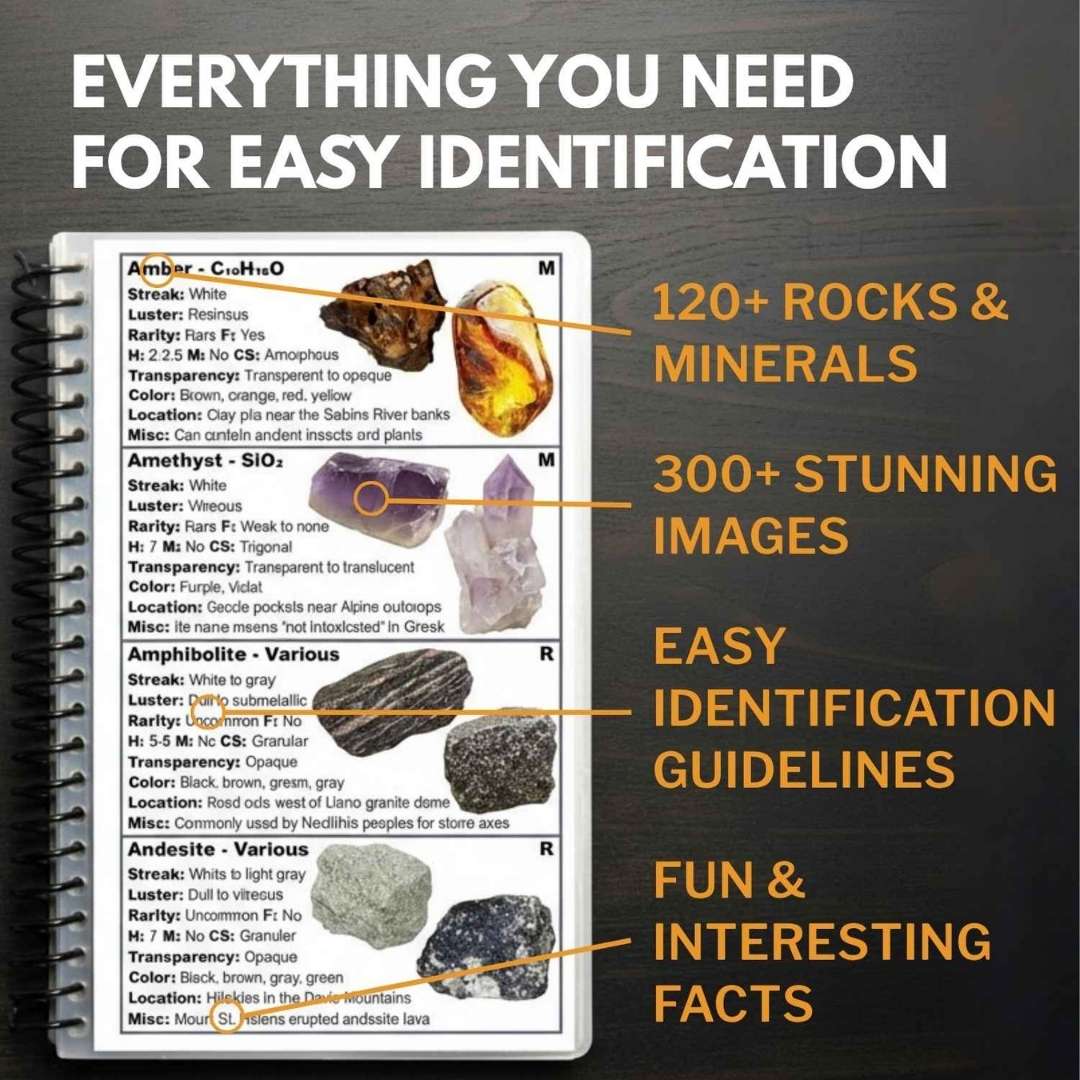Texas is full of surprises, and that includes its hidden treasures. Among them is garnet, a deep red gemstone that has been forming beneath the state’s surface for millions of years.
While Texas may not be the first place that comes to mind for garnet hunting, it holds more of these fiery stones than most people realize.
The rugged landscapes, ancient riverbeds, and weathered rock formations here have all played a role in shaping and revealing garnets. Some are buried in granite, while others get carried downstream, waiting to be discovered in the sand and gravel.
We’ll show you exactly where and how to track them down, but the only thing you’ll still need is a way to confidently identify what you’re picking up. The Texas Rocks & Minerals Identification Field Guide makes it easy to confirm every find on the spot and keeps you from walking right past something valuable without realizing it.
It’s a life saver.
How Garnet Forms Here
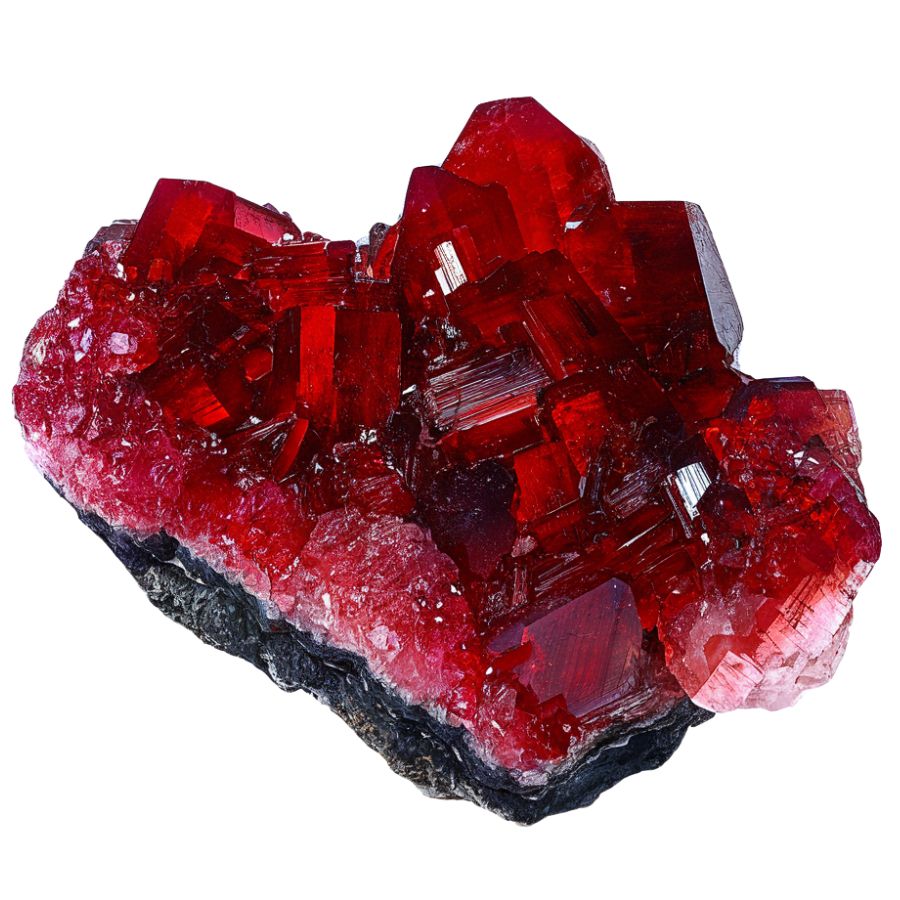
Garnet forms deep underground when rocks get squeezed and heated during metamorphism. Think of it like baking cookies – but instead of dough, you’ve got minerals like aluminum, iron, and silica getting cooked under intense pressure.
When these minerals reach temperatures around 400-700°C, they start rearranging their atoms into garnet’s distinctive crystal structure.
What’s cool is that garnets often grow by pushing other minerals out of the way! That’s why they form those perfect geometric shapes.
Most garnets need high pressure too, which is why they’re usually found in rocks that were once buried miles beneath the surface. The slower they grow, the bigger and clearer they become – some taking millions of years to reach their full size.
Types of Garnets
Garnets are captivating gemstones that showcase an impressive range of colors and varieties, each determined by their unique chemical composition. Understanding these differences helps in identifying the stone’s value.
Almandine Garnet
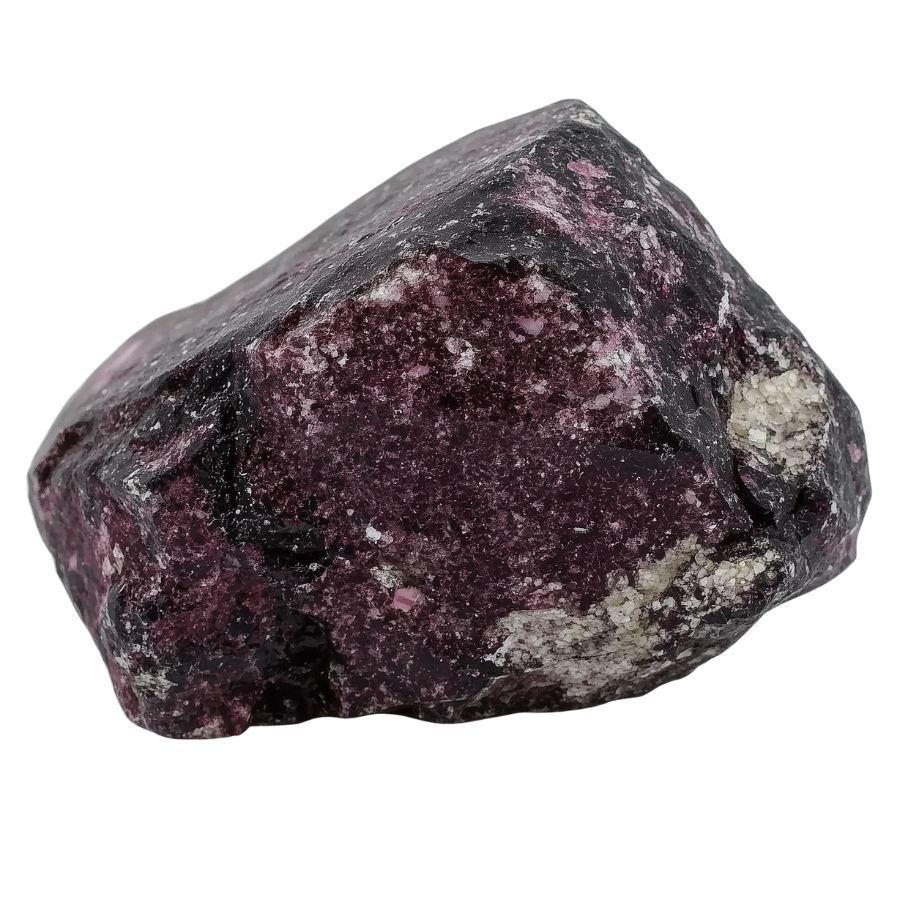
Almandine garnet stands out with its rich, deep red to reddish-brown color. The stone sometimes shows hints of orange or brown, making each piece unique. Its color intensity remains consistent throughout the stone, creating a beautiful depth that catches the eye.
The crystal structure of almandine follows a perfect cubic pattern, forming well-defined shapes with smooth faces. This symmetry contributes to its striking appearance and helps light bounce through the stone evenly.
What makes almandine special is its high iron content, which gives it a higher specific gravity than other garnets. This means it feels slightly heavier in your hand compared to similar-sized stones. Its refractive index of 1.74 to 1.83 creates excellent brilliance and fire.
Most almandine garnets are remarkably clear, though some may contain natural inclusions that create interesting patterns. These patterns can add character to the stone without affecting its overall beauty or durability.
If you want REAL results finding incredible rocks and minerals in Texas you need one of these 👇👇👇
Finding the coolest rocks in Texas isn’t luck, it's knowing what to look for. Thousands of your fellow rock hunters are already carrying Rock Chasing field guides. Maybe it's time you joined the community.
Lightweight, mud-proof, and packed with clear photos, it’s become the go-to tool for anyone interested discovering what’s hidden under our red dirt.
Join them, and make your next rockhounding trip actually pay off.
📘 Order the Texas Field Guide Now →
What makes it different:
🚙 Field-tested across Texas rivers, ranchlands, and roadcuts.
📘 Heavy duty laminated pages resist dust, sweat, and water.
🧠 Zero fluff — just clear visuals and straight-to-the-point info.
📍 Find hidden gems like Blue Topaz, Texas agate, and petrified wood fast.
⭐ Rated 4.8★ by real collectors who actually use it in the field.
Pyrope Garnet
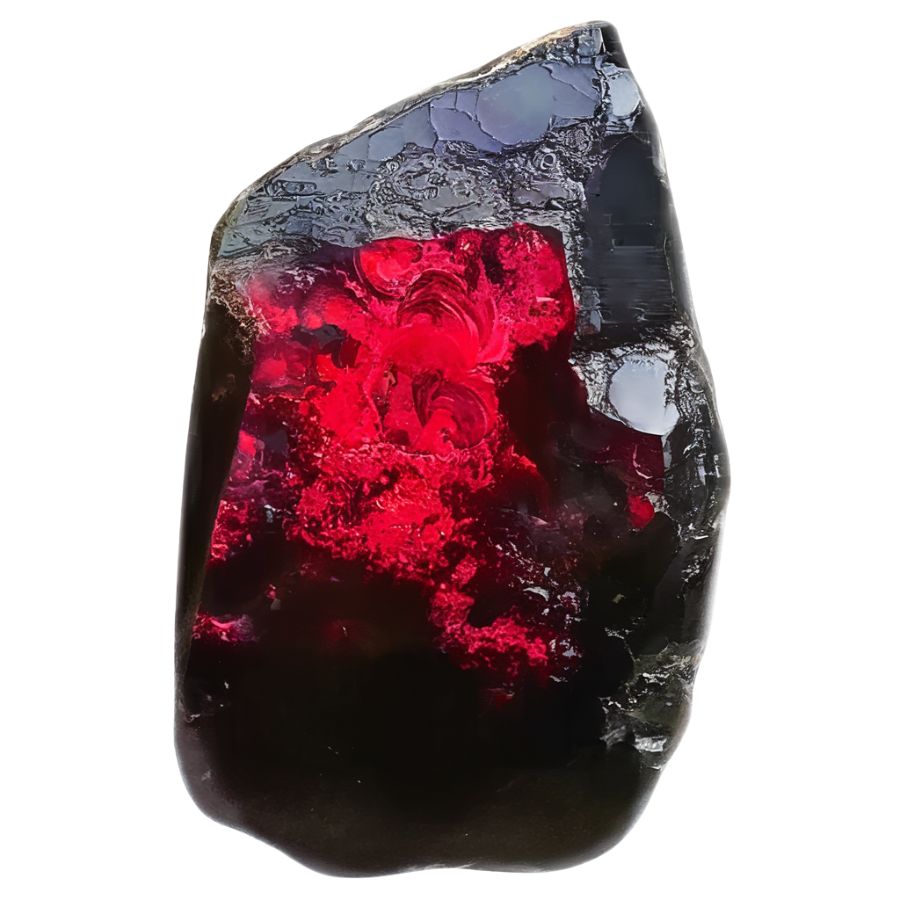
Pyrope garnet captivates with its intense red-to-purplish-red color. The color is so pure and vibrant that some specimens have earned the nickname “Cape Ruby.”
This stone has excellent clarity, rarely showing visible inclusions. When present, some inclusions can create a fascinating star effect called asterism, where a six-pointed star seems to float on the surface.
The stone appears especially vivid when cut into clean, geometric shapes that maximize light return.
Some pyropes show a subtle color shift, appearing slightly different under natural and artificial light. This subtle change adds to their charm and makes each stone unique.
Their exceptional clarity and lack of internal flaws make them particularly appealing to collectors.
Spessartine Garnet
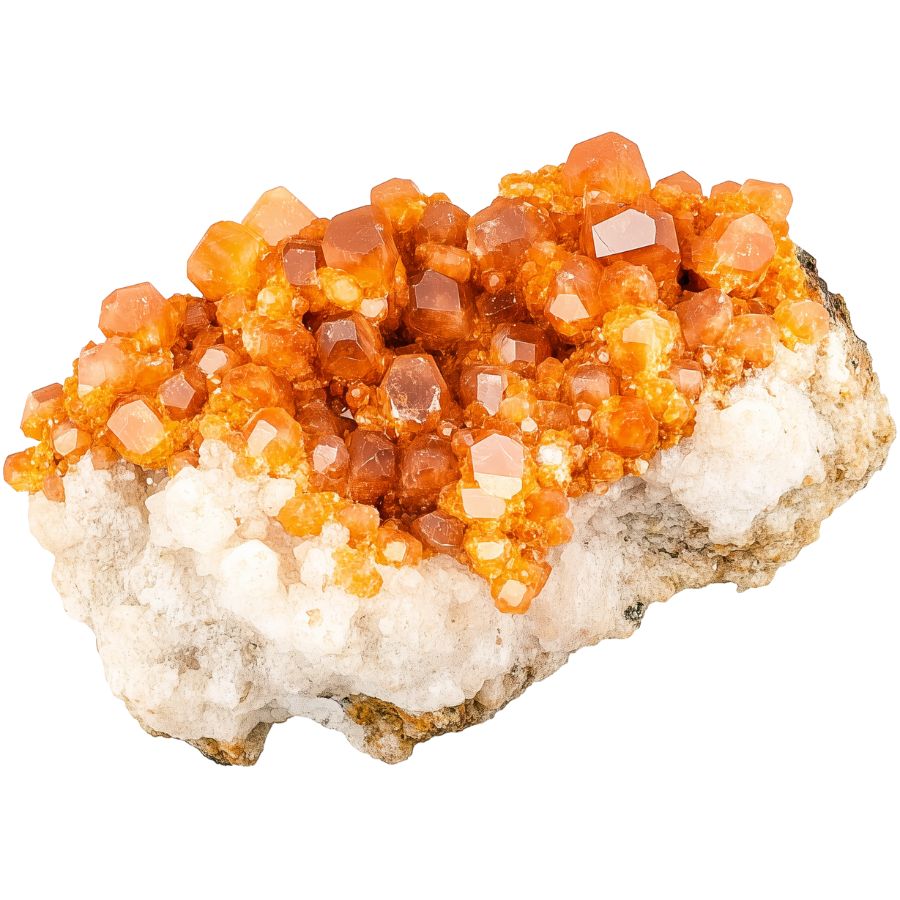
Spessartine garnet showcases a stunning range of orange colors, from bright mandarin to deep reddish-orange. The most valued pieces display a pure, vivid orange. This distinctive coloring comes from manganese in its chemical makeup.
When cut properly, spessartine exhibits bright flashes of light and exceptional sparkle. Some stones show a subtle “sugar-like” texture that creates a soft, internal glow.
Pure spessartine is rare in nature, making high-quality specimens particularly valuable. Most stones contain trace elements that create subtle color variations.
The stone’s transparency ranges from completely clear to slightly cloudy. Clear specimens are highly prized, but some collectors prefer stones with slight cloudiness that creates an interesting depth effect.
Andradite Garnet
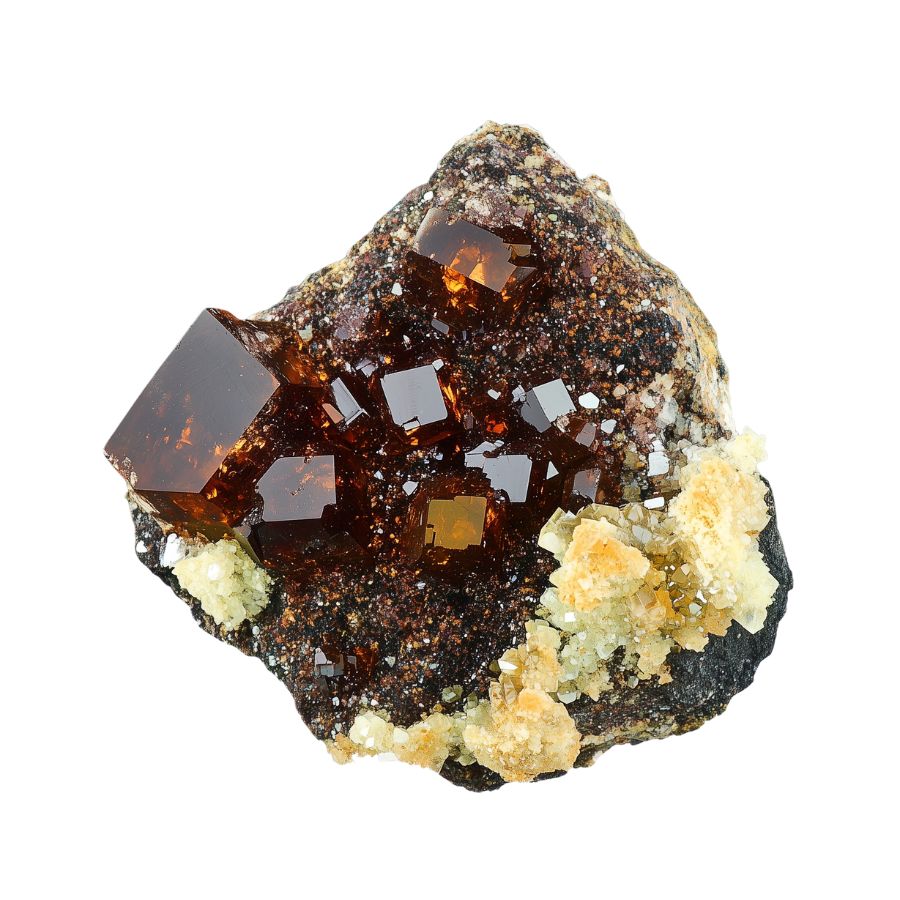
Andradite garnet displays the widest color range of all garnets. Colors span from bright green to yellow, brown, and black. The green variety, known as demantoid, is particularly treasured for its brilliant, emerald-like color and exceptional sparkle.
This stone has the highest dispersion rate of all garnets, even higher than diamond. This means it breaks light into rainbow colors more effectively, creating fascinating fire and brilliance.
Some andradite garnets contain unique internal features called “horsetail” inclusions. These fine, needle-like patterns are actually desired by collectors and add to the stone’s value.
The stone’s surface has a bright, glass-like luster that enhances its natural beauty. Some specimens exhibit unique optical features such as asterism (star-like patterns) and chatoyancy (cat’s eye effect), which further enhance their visual appeal.
Grossular Garnet
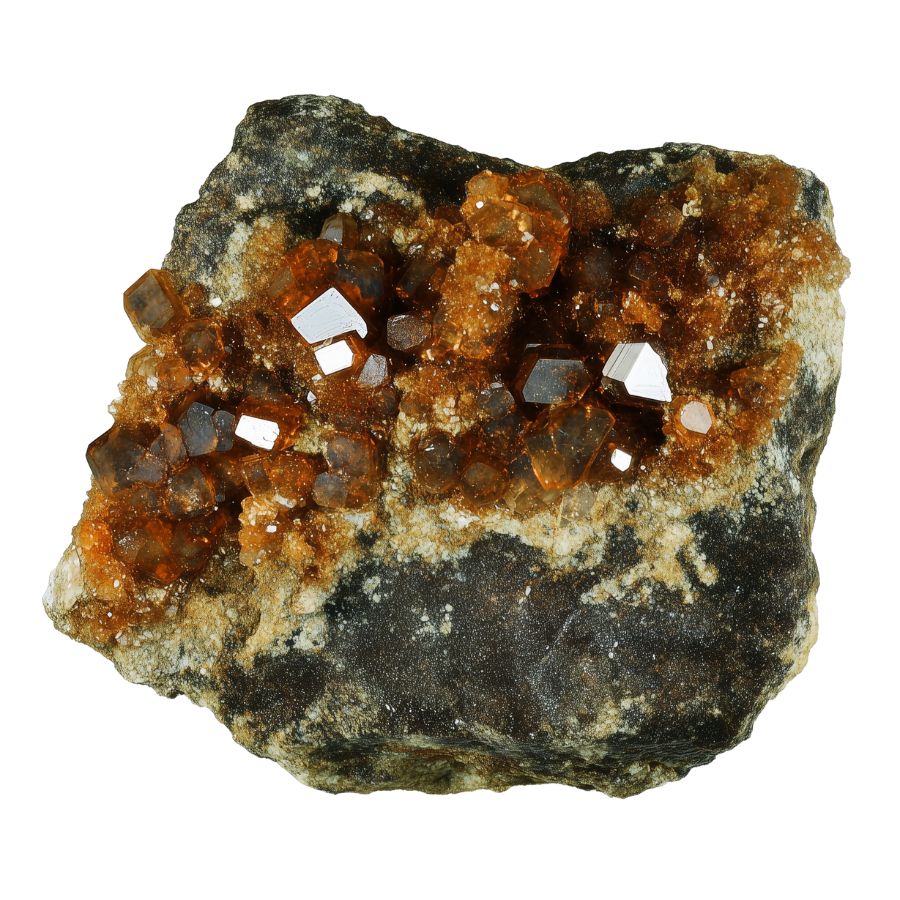
Grossular garnet comes in an amazing range of colors – from green and yellow to pink, orange, and even colorless. The most striking feature is the presence of internal swirls and streaks that create unique patterns within each stone.
The stone’s surface has exceptional brilliance that rivals expensive gems like emeralds. Light bounces through it beautifully, creating bright flashes and sparkles.
A special variety called Mint Garnet glows under ultraviolet light, creating an otherworldly effect. This unusual property makes it particularly interesting to collectors. The stone’s clarity is typically excellent, with few visible impurities.
The presence of trace elements like chromium and vanadium creates its varied colors. These elements mix in different amounts, resulting in subtle color variations that make each stone unique.
Some pieces show color zoning, where different shades blend together in distinct patterns.
Uvarovite Garnet
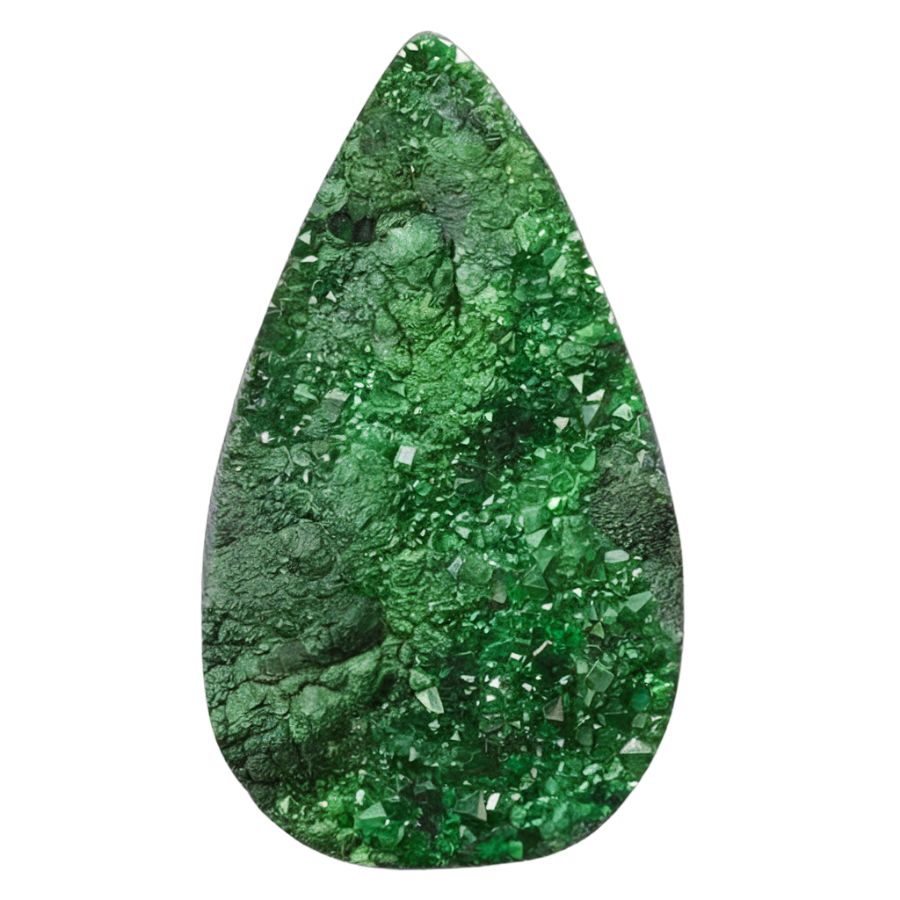
Uvarovite garnet displays a striking emerald-green color that remains consistent in all specimens. Unlike other garnets, where green hues may arise from chromium impurities, uvarovite’s green is inherent to its composition.
Instead of forming large crystals, uvarovite typically grows in clusters of tiny crystals. These clusters, called druzy, create sparkling surfaces that look like green sugar coating the rock beneath.
Under ultraviolet light, it shows an unexpected red glow, adding another layer of interest for collectors. This fluorescence is a unique feature not commonly found in other garnets.
These stones rarely grow large enough for traditional gem cutting. However, their natural crystal formations are so beautiful that they’re often left in their original state. The tiny crystals catch light from multiple angles, creating a dazzling display.
Rhodolite Garnet
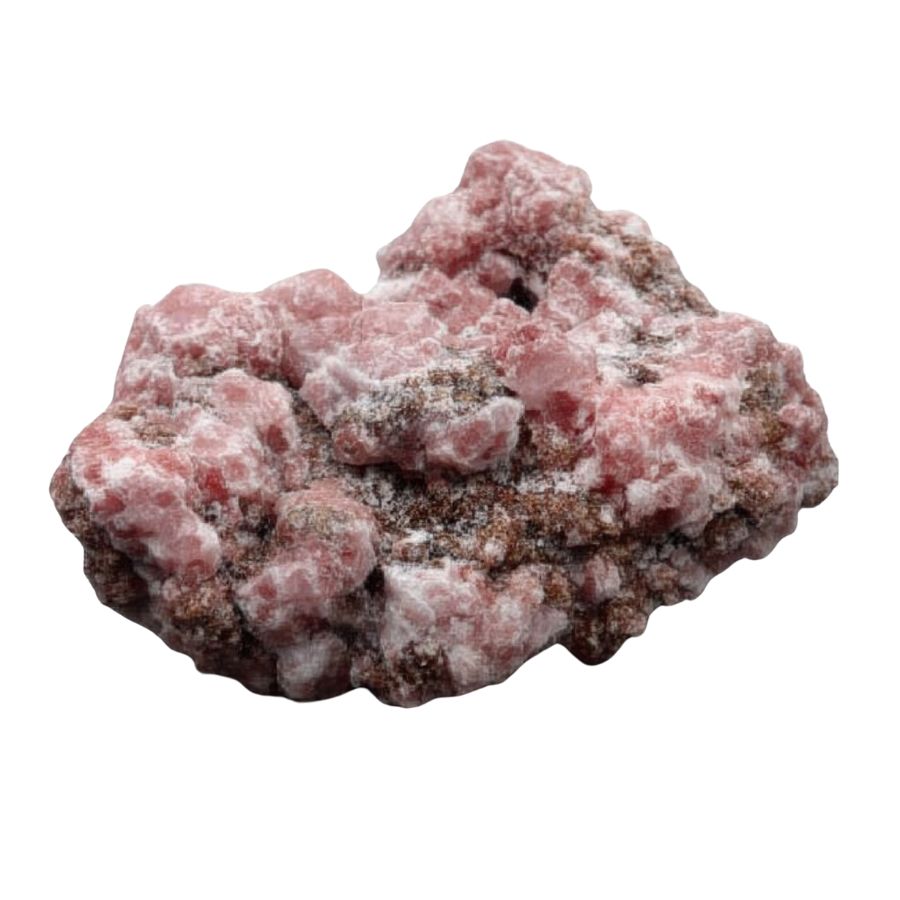
Rhodolite garnet stands out with its beautiful purple-red to raspberry-pink colors. The colors can shift between purple and red depending on the lighting, creating an interesting play of hues. This color range makes it distinctly different from the deeper reds of other garnets.
The stone’s clarity is typically excellent, with very few internal features visible to the naked eye. The surface has a glass-like shine that enhances its natural beauty.
What makes rhodolite special is its mixed composition of two different garnet types. This mixture creates its unique color range and optical properties. The stone often shows stronger color saturation in its center, fading slightly toward the edges.
Rhodolite garnet is particularly valued for its vibrant colors that can mimic more expensive gemstones like rubies and amethysts, making it a popular choice among collectors and jewelers alike.
Hessonite Garnet
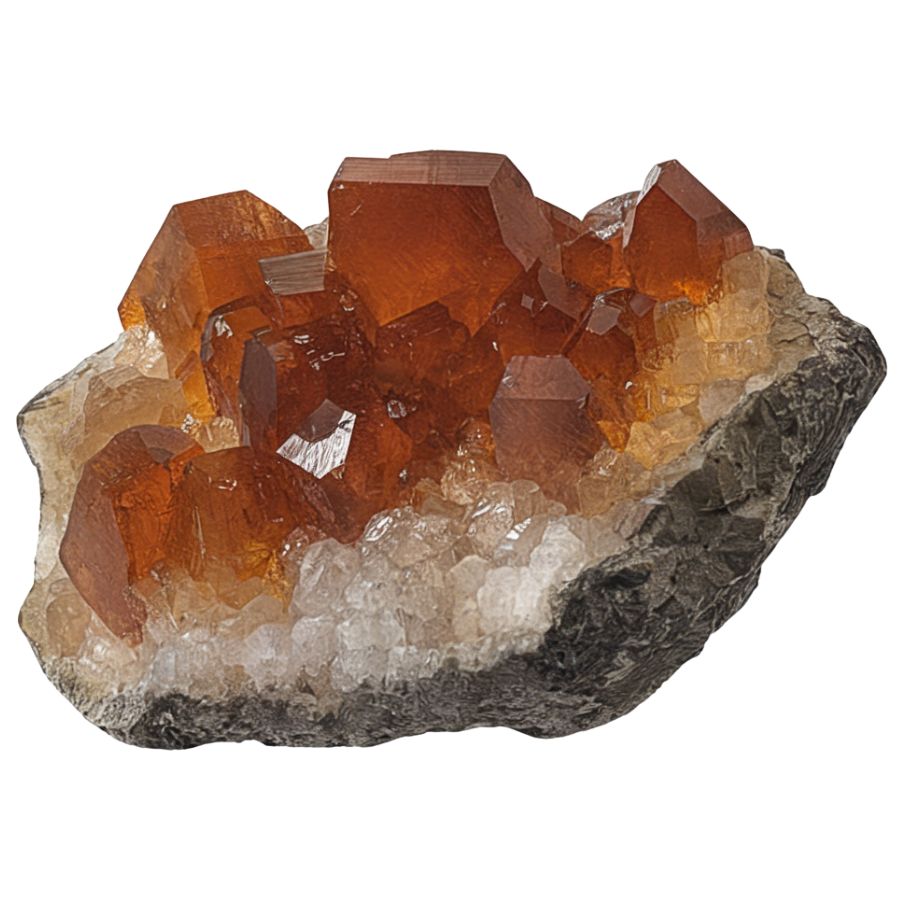
Hessonite garnet showcases warm honey-to-cinnamon colors, ranging from golden yellow to deep reddish-brown. Some pieces display hints of purple, creating complex and appealing color combinations.
Inside the stone, you might find interesting patterns created by tiny needle-like crystals. Unlike many gems where inclusions reduce the value, these internal features are appreciated in Hessonite. They create unique patterns that make each stone one-of-a-kind.
The stone’s transparency varies from crystal clear to slightly cloudy. This variation can create interesting effects, especially when light passes through the stone. Some pieces show a subtle glow that seems to come from within.
High-quality hessonite stones are relatively uncommon, especially in larger sizes. Their warm colors and unique internal features make them particularly interesting to collectors.
Tsavorite Garnet
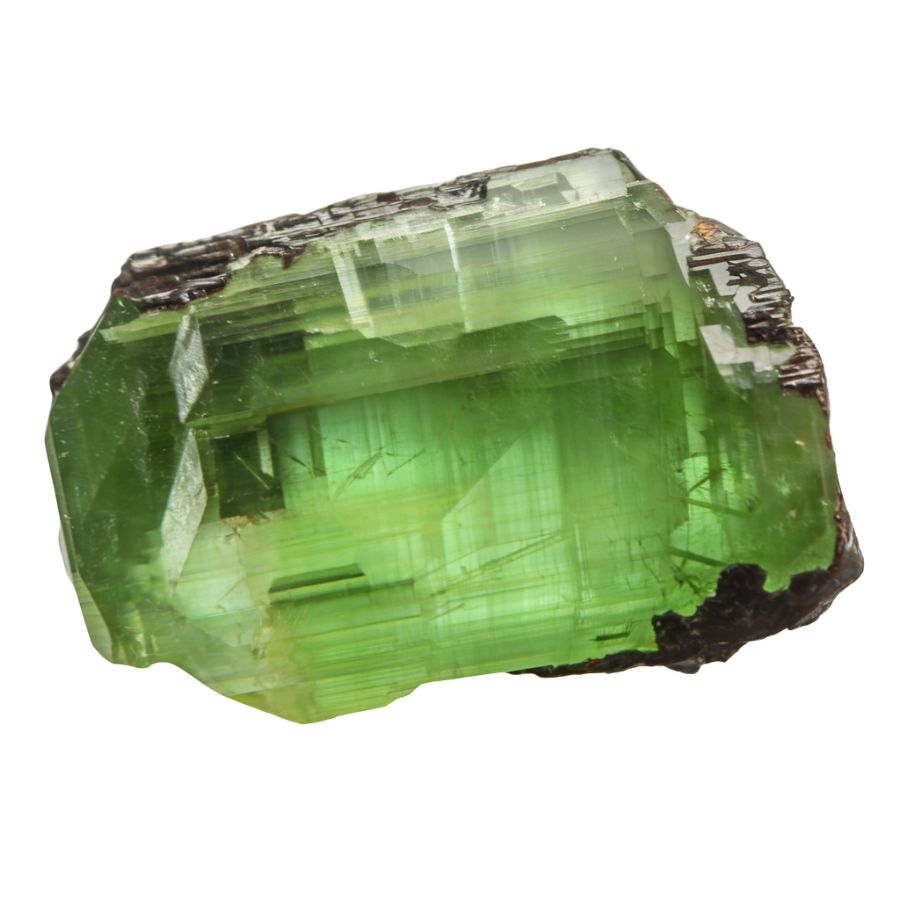
Tsavorite garnet displays a brilliant green color that ranges from bright lime to deep forest green. This stunning color comes from tiny amounts of chromium and vanadium in the stone.
The green is so pure and vibrant that it often matches or surpasses the color of fine emeralds. The surface has a glass-like shine that makes the stone look alive with movement.
Each tsavorite has its own personality in terms of color depth and brightness. Some stones show subtle color changes under different lighting, while others maintain a consistent deep green.
Star Garnet
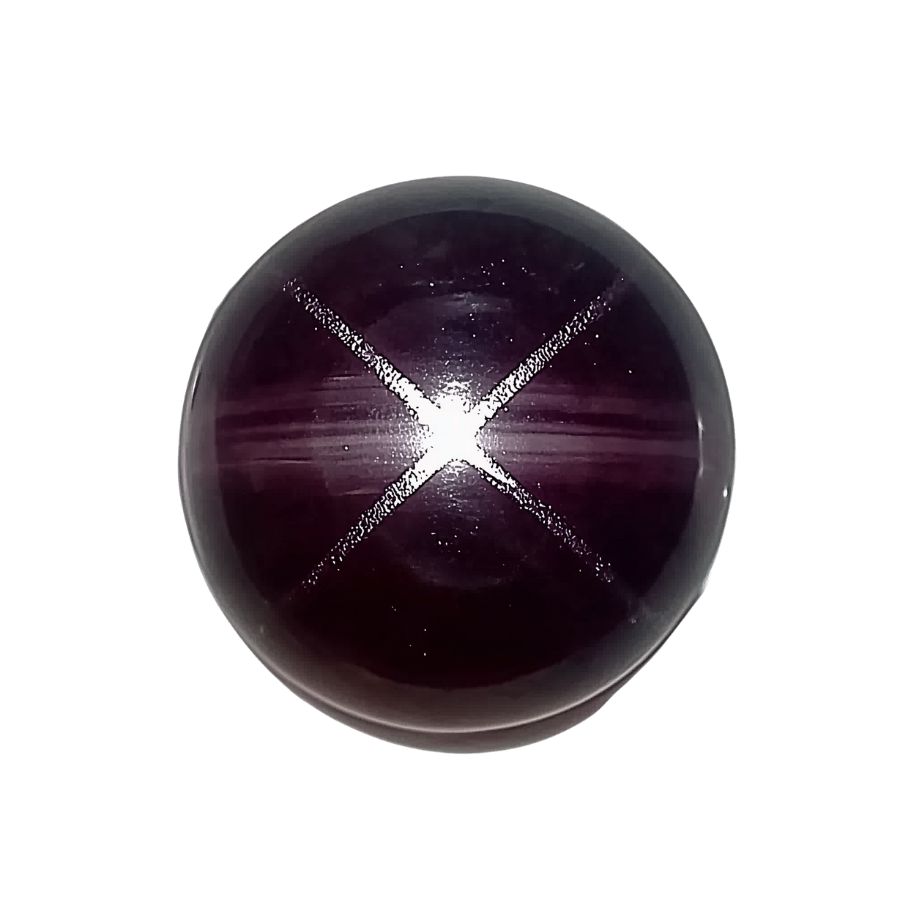
Star garnet shows a fascinating light pattern that looks like a star floating on its surface. This effect, called asterism, comes from tiny needle-like crystals inside the stone. The star usually has four or six rays that move as you turn the stone under light.
The stone’s color is typically deep red to purple-red, often with brown undertones. When polished into a smooth, rounded shape, the star effect becomes more prominent.
The best specimens show sharp, well-defined star rays against a rich, even background color. These stones are quite special because not all garnets can form stars.
The right conditions during formation must exist for the star effect to develop. The tiny crystals inside must align perfectly to create the star pattern. The star effect is natural and permanent – it won’t fade or change over time.
What Rough Garnets Look Like?
Garnets display unique identifying traits when found in their raw, natural state. Look for these distinguishing features:
Look for Distinctive Angular Shapes
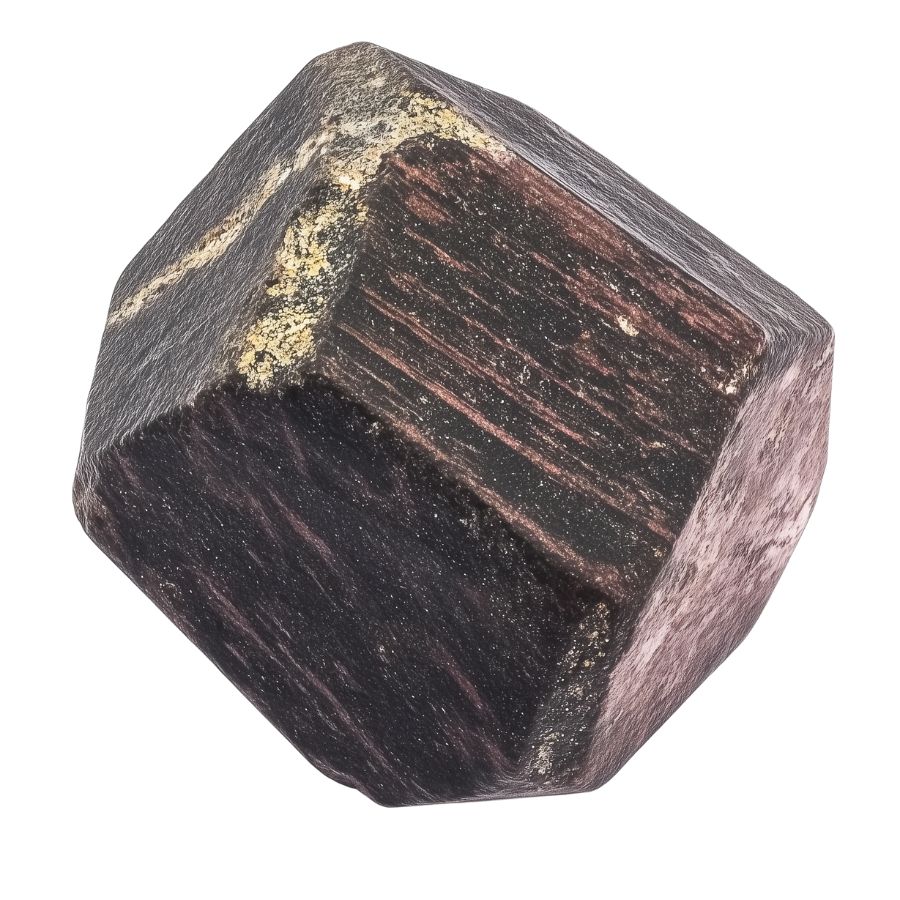
Raw garnet typically forms in dodecahedral or trapezoidal crystal shapes. Think of it like tiny, naturally-formed geometric shapes.
Unlike smooth river rocks, rough garnets have sharp edges and flat faces. Even when broken, they tend to maintain these angular patterns. You’ll often spot them as chunky, block-like crystals that look like they’ve been roughly carved.
Check the Color Range and Transparency
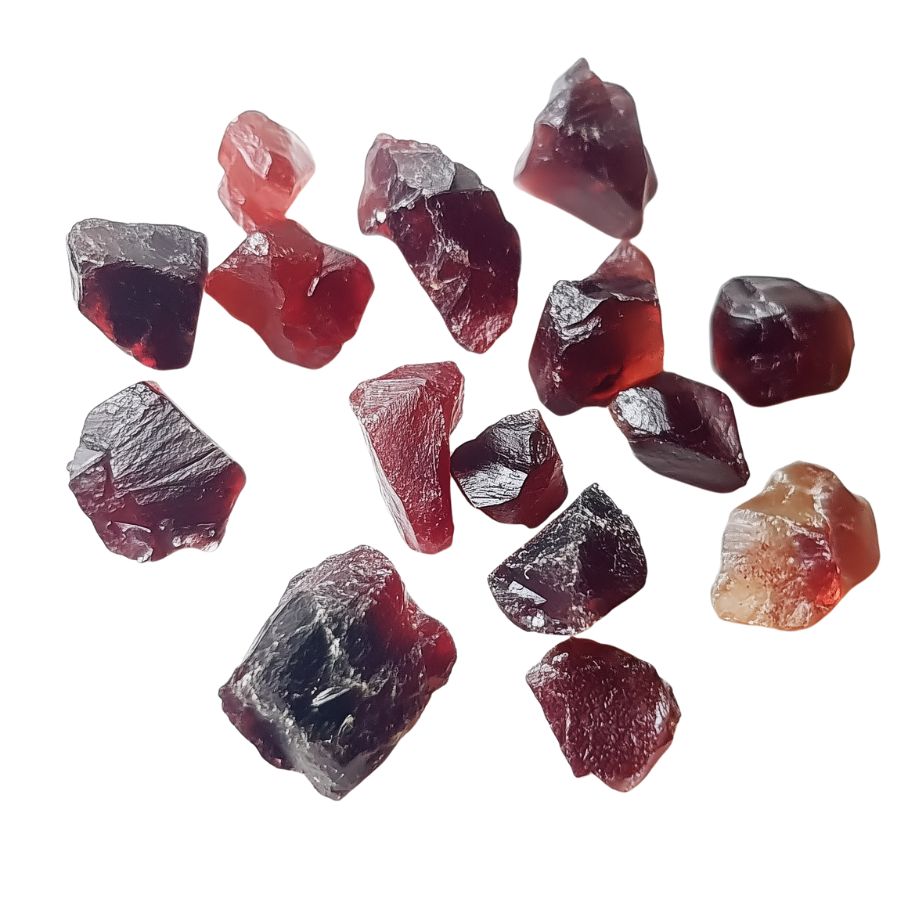
Garnets aren’t just red! Look for deep wine colors, but also keep an eye out for orange-brown, green, or even black varieties.
Hold it up to light – rough garnets often show some translucency at the edges, even if the center seems opaque.
Examine the Surface Texture
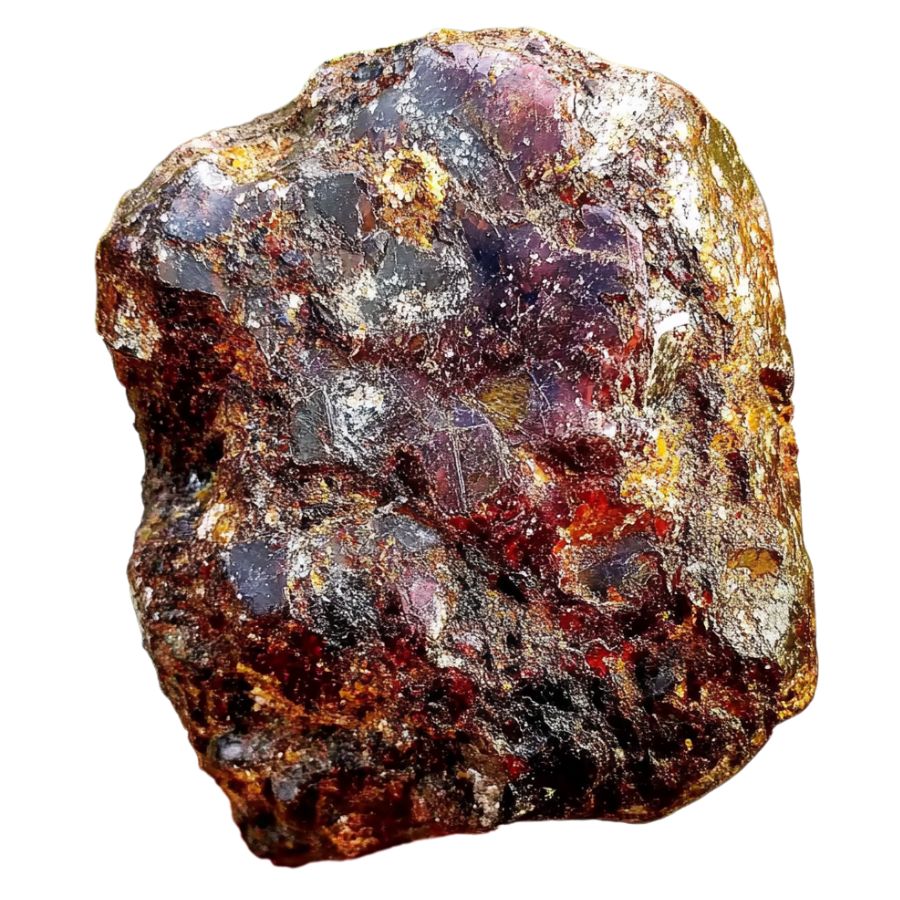
Raw garnets have this unique, almost greasy-looking surface luster. Not shiny like glass, but more like wet plastic.
Run your finger over it – you should feel a smooth yet slightly waxy texture. If it’s been weathered, the surface might be slightly pitted or rough, but you’ll still see that characteristic luster in protected areas.
Test the Hardness and Toughness
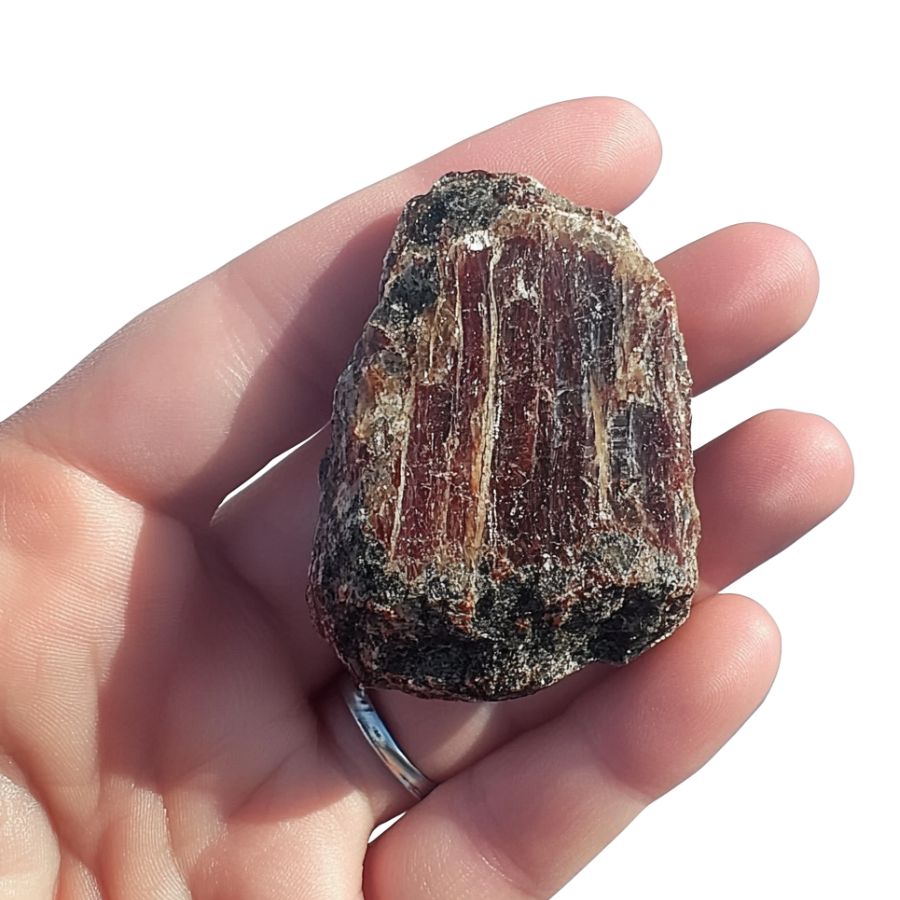
Here’s a quick field test: garnets can easily scratch a penny but won’t scratch quartz. They’re surprisingly heavy for their size – noticeably heavier than a similar-sized piece of quartz or feldspar. Don’t be fooled by lighter stones that look similar!
The Tools You Will Need

Garnets may not always be huge but spotting one in the wild feels like striking treasure. The good news is you do not need fancy gear to start searching.
Just a few simple tools can help you spot, protect, and properly identify what you find.
A High Quality Field Guide – Essential
A field guide is the most powerful tool you can bring. It helps you quickly tell real garnets from ordinary pebbles so you do not waste time guessing. It also shows how garnets look in different stages, from rough to water worn, which makes you way better at spotting them in creeks or river gravel.
A good guide also protects you from mistaking fake glass for the real thing.
The Texas Rocks & Minerals Field Guide is perfect for this. It is waterproof, lightweight, and packed with real photos of more than 120 Texas rocks and gemstones, so you can make fast identifications right there in the field without pulling out your phone.
Hand Shovel or Trowel
Garnets often sit in gravel bars or tucked into shallow banks. A small hand shovel lets you dig just enough without disturbing a large area. It is easy to carry and helps you reach into the tight pockets where heavier minerals like garnet collect.
Sifting Screen or Classifier
A sifting screen helps you shake away loose sand and keep only gravel and stones worth inspecting. It makes the search much faster and helps you spot small garnet crystals that would be almost impossible to see otherwise.
Soft Brush or Water Spray Bottle
Garnets can look dull when covered in dust or dried mud. A quick rinse or gentle brush instantly reveals their natural red or brown shine. This makes it much easier to spot the sparkle that tells you it might be worth keeping.
Durable Work Gloves
Loose gravel and river stone can be sharp on the hands. Gloves protect your fingers from cuts and scrapes while still letting you handle small stones with precision. They also make longer hunts far more comfortable.
A Quick Request About Collecting
Always Confirm Access and Collection Rules!
Before heading out to any of the locations on our list you need to confirm access requirements and collection rules for both public and private locations directly with the location. We haven’t personally verified every location and the access requirements and collection rules often change without notice.
Many of the locations we mention will not allow collecting but are still great places for those who love to find beautiful rocks and minerals in the wild without keeping them. We also can’t guarantee you will find anything in these locations since they are constantly changing.
Always get updated information directly from the source ahead of time to ensure responsible rockhounding. If you want even more current options it’s always a good idea to contact local rock and mineral clubs and groups
Tips on Where to Look
To increase your chances of finding garnets, focus your search on these favorable areas:
Metamorphic Rock Outcrops

Look for dark-colored metamorphic rocks, especially schist and gneiss. These rocks often have visible layers or bands.
Garnets appear as dark red or brownish-red crystals embedded in the rock. Common near hiking trails and road cuts where metamorphic rocks are exposed.
Stream Beds & Gravel Banks
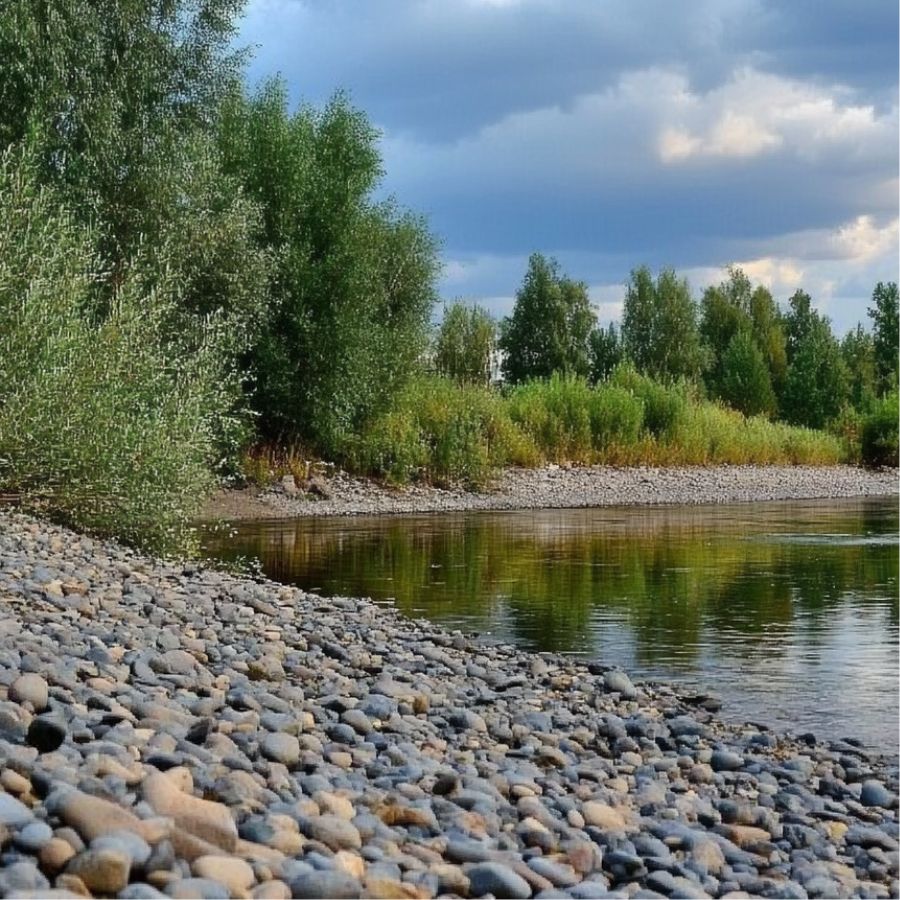
Check gravel deposits in streams, especially after heavy rains. Garnets are heavier than most minerals, so they concentrate in stream bends where water slows down.
Use a pan or sieve to sort through the gravel, keeping an eye out for the distinctive reddish crystals that glimmer when wet.
Pegmatite Areas
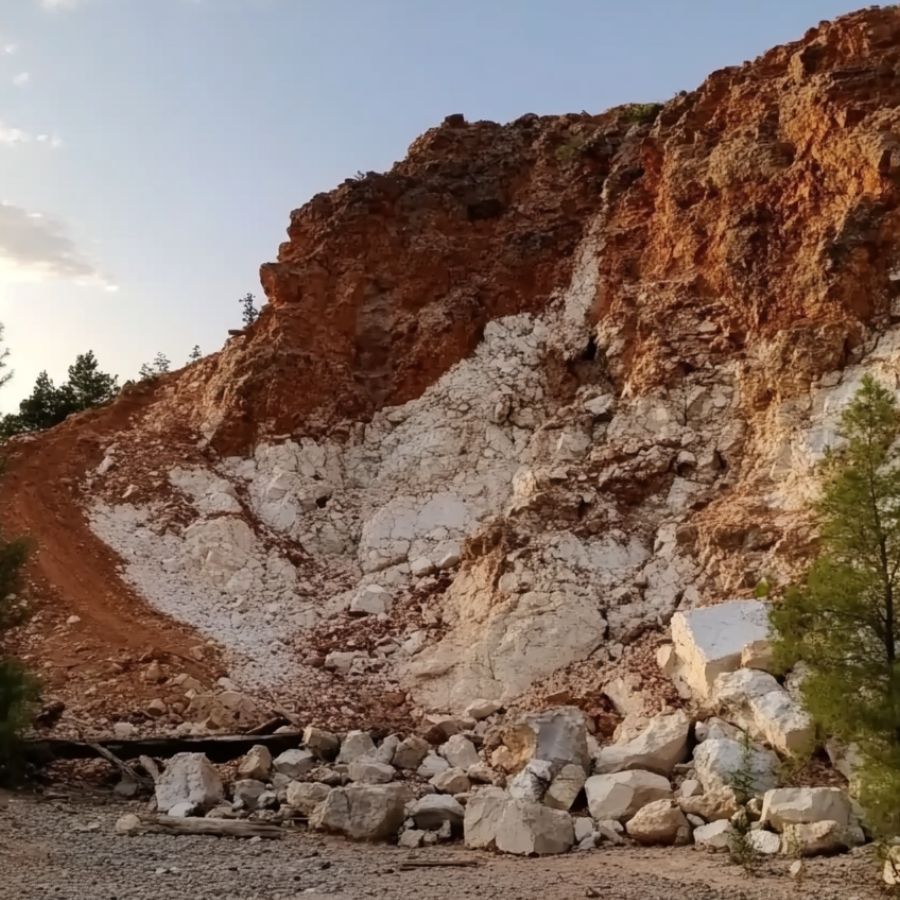
Search around pegmatite formations, which are coarse-grained igneous rocks that sometimes form large crystal pockets where beautiful garnet specimens can be found nestled among other minerals like mica and feldspar.
These areas often have scattered surface rocks and exposed cliff faces that weather over time, releasing garnet crystals.
Old Mining Areas
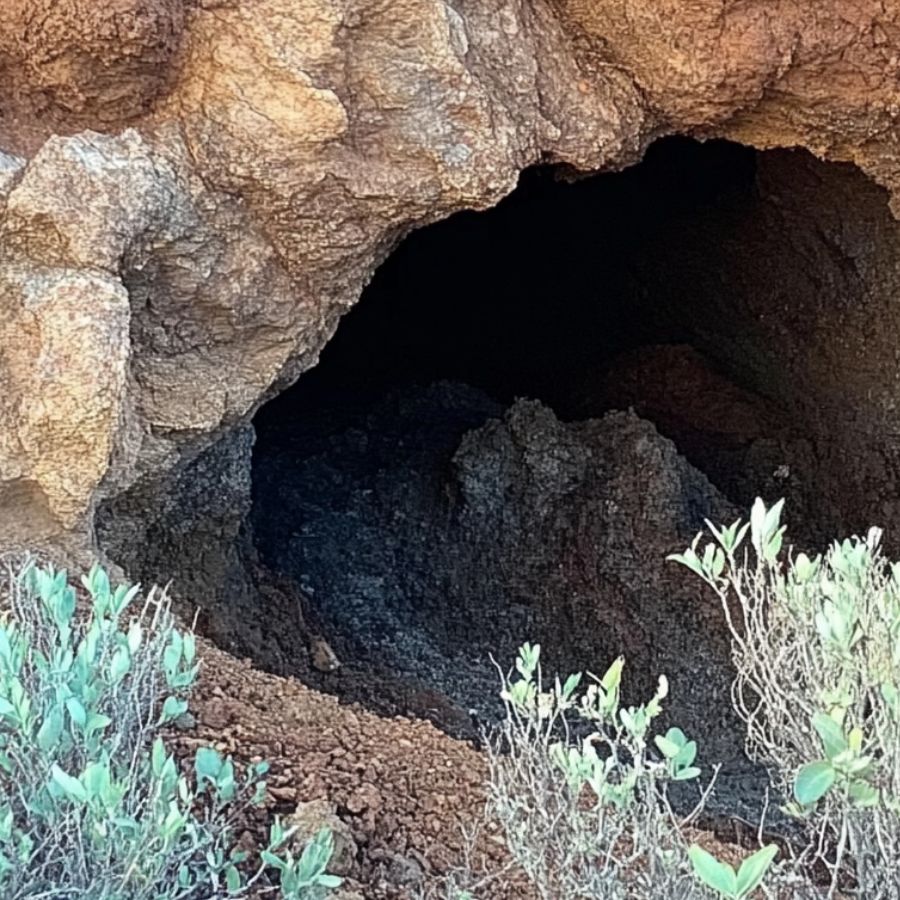
Explore permitted public mining dumps and tailings piles near historical mica or feldspar mines, where garnet was often discarded as a byproduct during past mining operations and can still be found in abundance among the leftover material.
Some Great Places To Start
Here are some of the better places in the state to start looking for garnet:
Always Confirm Access and Collection Rules!
Before heading out to any of the locations on our list you need to confirm access requirements and collection rules for both public and private locations directly with the location. We haven’t personally verified every location and the access requirements and collection rules often change without notice.
Many of the locations we mention will not allow collecting but are still great places for those who love to find beautiful rocks and minerals in the wild without keeping them. We also can’t guarantee you will find anything in these locations since they are constantly changing.
Always get updated information directly from the source ahead of time to ensure responsible rockhounding. If you want even more current options it’s always a good idea to contact local rock and mineral clubs and groups
Packsaddle Mountain

Packsaddle Mountain is one of the best places in Texas to find garnet. Located in Llano County, this rocky mountain is filled with minerals, including deep-red garnets.
The best way to find garnets is to search in the gravel beds at the base of the mountain. Over time, rain and wind have broken the rocks apart, releasing the garnets into the soil. Sometimes, you can spot small garnets on the ground, but for bigger ones, you may need to use a rock hammer.
This area is great for rockhounds of all skill levels. Along with garnets, you might also find quartz and topaz.
You've probably walked past some incredible rocks and minerals. You need this guide 👇👇👇
We've all come across a cool rock that we could have sworn was rare or valuable but couldn't tell what it was.
If you're not 100% confident that you know every rock and mineral in Texas this guide is for you.
The Texas Rocks & Minerals Field Guide helps you ID what you find in seconds, from Hill Country agates to Llano granite, with crisp photos, simple charts, and zero fluff.
→ Grab your copy today and spot your next gem before anyone else does.
What this guide unlocks:
🧭 Confidence in the field — ID rocks fast and move on to the next find
🎒 Lightweight and waterproof — built for trails, not coffee tables
🌅 Weekend adventures — find treasures on rivers, ranches, and roadsides
🤠 Texas pride — explore the real geological beauty of your state
🔥 Motivation — every trip outside feels like a hunt for hidden gems
Comanche Creek Area
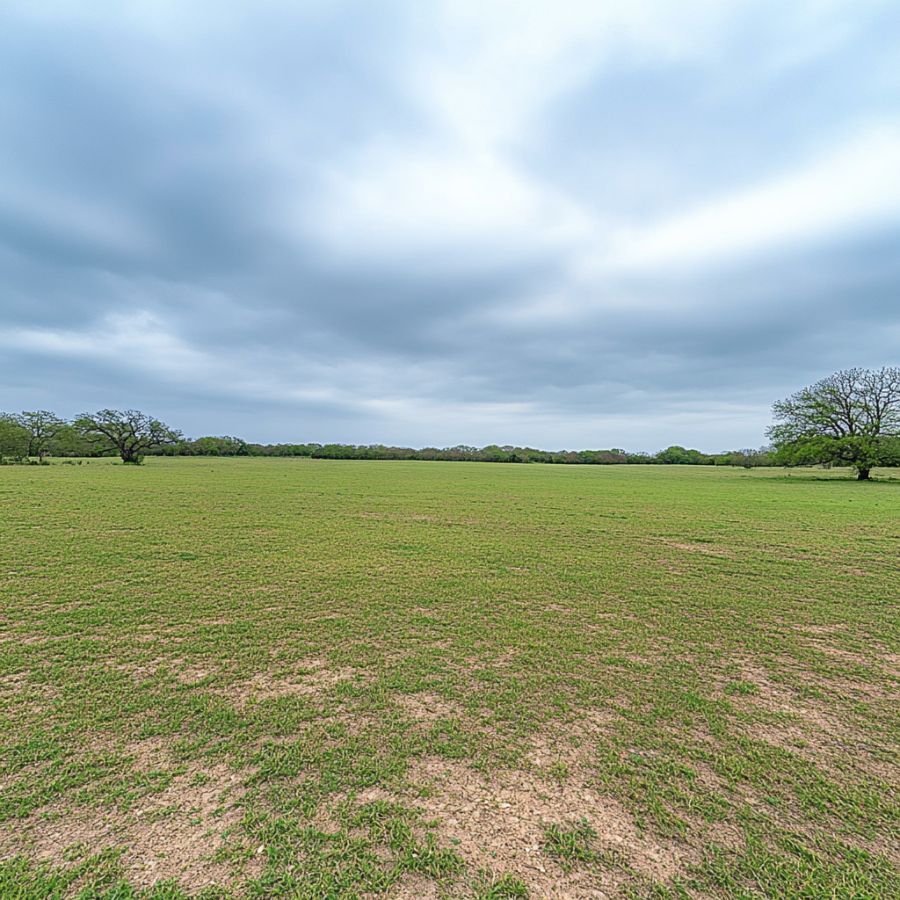
Comanche Creek in Blanco County is a hidden treasure for rock collectors. This area has rocks like granite and schist, which often contain garnets. The garnets found here are typically almandine, with deep reddish hues that contrast beautifully against the surrounding rock.
One of the best ways to search for garnets is by looking in the gravel along the creek, especially after a heavy rain. Rainwater washes away dirt, making it easier to spot the gemstones.
Since this area is not very crowded, it’s a peaceful place for rockhounding. You should bring gloves, a rock hammer, and a small bag to carry your finds.
Pecan Bayou

Pecan Bayou in San Saba County is a great place to search for garnets. This winding stream has carried minerals from the surrounding rocks for thousands of years. The garnets here are usually small but have a deep red or reddish-purple color.
The best way to find garnets is by searching the gravel bars along the bayou. Water naturally separates heavier minerals, so garnets often settle in certain spots. Using a sifting pan or just your hands, you can sort through the pebbles to find tiny gems.
Pecan Bayou is an easy-to-access location, making it perfect for beginners. It’s also a great place to enjoy the outdoors, with peaceful water and shady trees. Whether you’re an experienced collector or just starting out, this spot is a fun place to find some Texas garnets!
Sierra Blanca Peaks
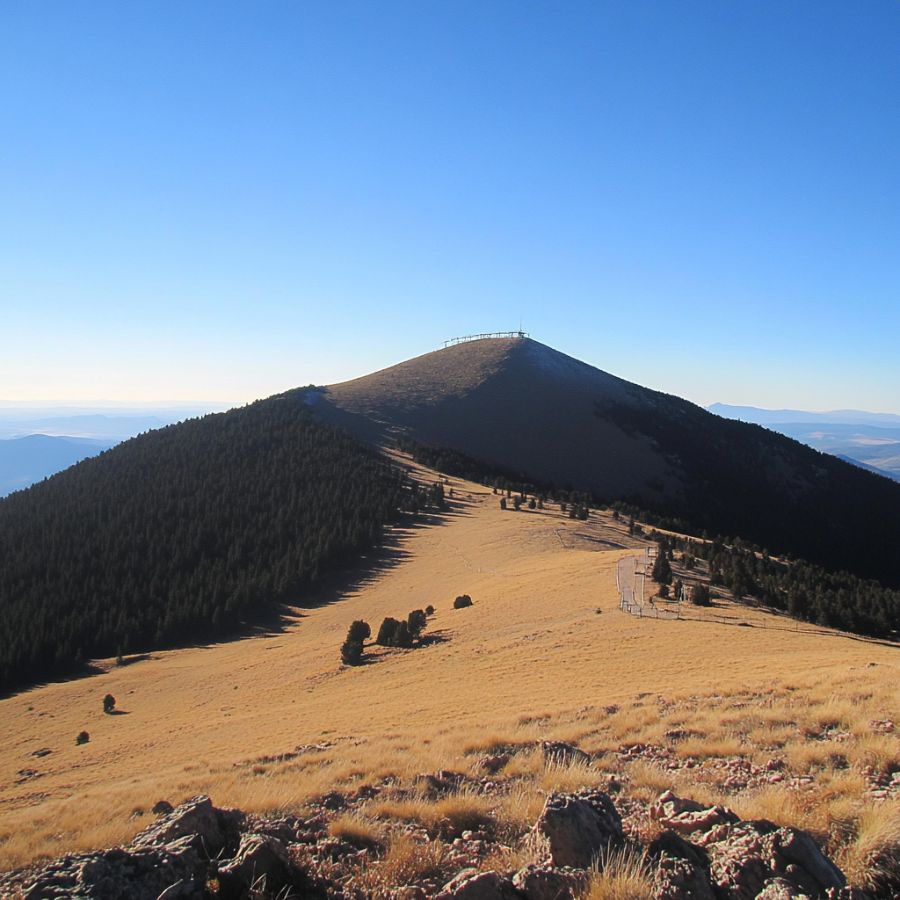
Sierra Blanca Peaks, located in Hudspeth County, is an exciting place for rockhounds looking for garnets. The mountains here contain old metamorphic rocks, which often hold beautiful garnet crystals.
The best way to search for garnets is by looking along dry creek beds or at the base of rocky slopes. Over time, wind and water wear down the rocks, releasing garnets into the soil. Some of the best finds come from breaking apart weathered rocks with a rock hammer.
This location is more remote than others, so it’s best for those who enjoy adventure. The rocky terrain means you should wear sturdy boots and bring plenty of water. While the hike may take some effort, finding deep-red garnets in the wild makes the trip worth it!
Sandy Creek
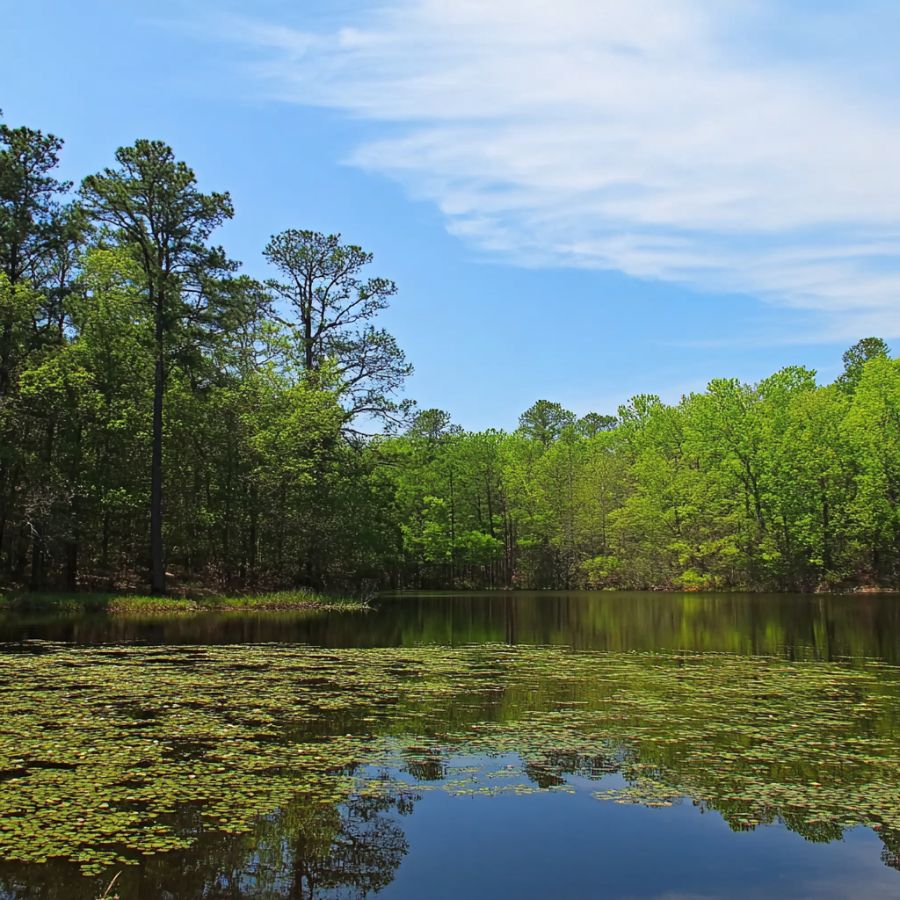
Sandy Creek in Llano County is a great place to find garnets, especially for beginners. The creek flows through an area rich in minerals, making it a perfect spot to search for gemstones.
Since garnets are heavier than other rocks, they often settle in slower-moving parts of the creek.
Searching in the gravel bars or digging into the sandy banks can help you find small, rounded garnets. If you bring a sifting pan, you might be able to find even more!
Places Garnet has been found by County
After discussing our top picks, we wanted to discuss the other places on our list. Below is a list of the additional locations along with a breakdown of each place by county.
| County | Location |
| El Paso | Road cuts along Route 375 |
| Gillespie | Stream gravels around Fredericksburg |
| Mason | Fly Gap Road |
| Llano | Llano River banks |
| Llano | Babyhead Mountain area |
| Llano | Miller Mountain area |
| Gillespie | Willow City area |
| Mason | James River Road |
| San Saba | Hickory Sandstone formations |
| Llano | Enchanted Rock State Natural Area |
| Llano | Sandy Creek |
| Llano | Honey Creek |
| Gillespie | Big Sandy Creek |
| Gillespie | South of Llano near Willow City |
| Mason | Mason County pegmatite exposures |
| Mason | Old Mason Road pegmatite |
| Mason | Seaquist Ranch |
| Mason | Lindsay Ranch |
| Mason | Bar M Ranch |
| Mason | Clear Creek |
| Mason | Hickory Creek |
| San Saba | San Saba River |
| San Saba | Colorado River |
| San Saba | Cherokee Creek |
| San Saba | Pecan Bayou |
| Burleson | Rabb’s Creek |

